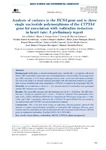Analysis of variants in the HCN4 gene and in three single nucleotide polymorphisms of the CYP3A4 gene for association with ivabradine reduction in heart rate: a preliminary report

Ver/Abrir
Use este enlace para citar
http://hdl.handle.net/2183/17552
Excepto si se señala otra cosa, la licencia del ítem se describe como Atribución-NoComercial-SinDerivadas 3.0 España
Colecciones
Metadatos
Mostrar el registro completo del ítemTítulo
Analysis of variants in the HCN4 gene and in three single nucleotide polymorphisms of the CYP3A4 gene for association with ivabradine reduction in heart rate: a preliminary reportAutor(es)
Fecha
2016Cita bibliográfica
Núñez L, Crespo-Leiro MG, Marrón-Liñares GM, et al. Analysis of variants in the HCN4 gene and in three single nucleotide polymorphisms of the CYP3A4 gene for association with ivabradine reduction in heart rate: a preliminary report. Cardiol J.2016;23(5):573-582
Resumen
[Abstract] Background: Ivabradine, a selective bradycardic drug, inhibits the If. In patients with heart failure (HF), ivabradine reduces the risk of rehospitalization and mortality. The average heart rate (HR) reduction is 8–10 beats, although clinical trials reveal interindividual variability. The aim of the study is to identify variants associated with HR reduction produced by ivabradine in genes involved in the drug metabolism (CYP3A4) or related to the drug target (HCN4).
Methods: In an exploratory cohort (n = 11), patients started on ivabradine were genotyped and the HR reduction was studied.
Results: The mean HR reduction after the treatment was 18.10 ± 12.26 bpm. The HR reduction was ≥ 15 bpm in 3 patients and > 5 and < 15 bpm in 7 patients. Four synonymous variants, L12L, L520L, P852P, and P1200P, were detected in the HCN4 gene (frequency = 0.045, 0.045, and 0.681, respectively). Moreover, the CYP3A4*1F and CYP3A4*1B were found in one patient each and CYP3A4*1G was presented in 3 patients.
Conclusions: This is the first study using an exploratory pharmacogenetic approach that attempts to explain interindividual variability in ivabradine HR reduction. However, more research must be undertaken in order to determine the role of variants in HCN4 and CYP3A4 genes in response to ivabradine.
Palabras clave
Heart failure
Ivabradine
HCN4
CYP3A4
Pharmacogenetic
Ivabradine
HCN4
CYP3A4
Pharmacogenetic
Versión del editor
Derechos
Atribución-NoComercial-SinDerivadas 3.0 España
ISSN
1897-5593
1898-018X
1898-018X






